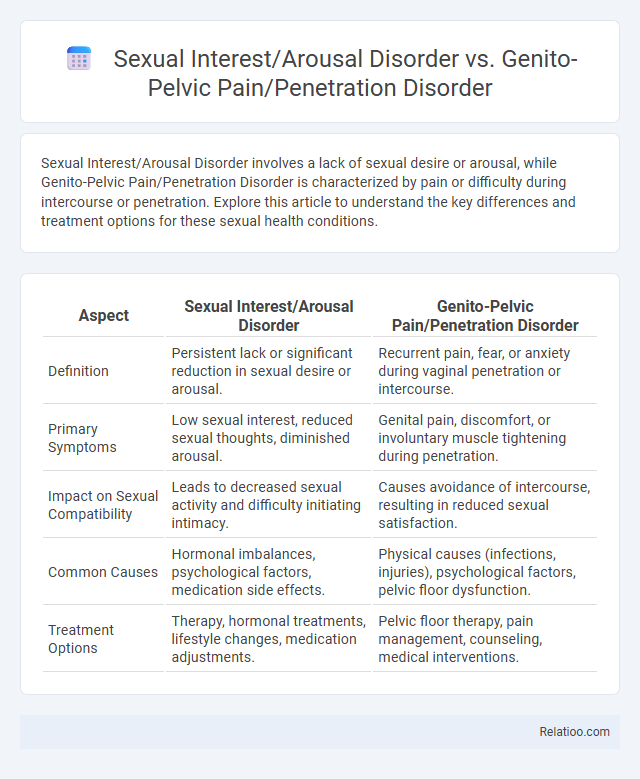Sexual Interest/Arousal Disorder involves a lack of sexual desire or arousal, while Genito-Pelvic Pain/Penetration Disorder is characterized by pain or difficulty during intercourse or penetration. Explore this article to understand the key differences and treatment options for these sexual health conditions.
Table of Comparison
| Aspect | Sexual Interest/Arousal Disorder | Genito-Pelvic Pain/Penetration Disorder |
|---|---|---|
| Definition | Persistent lack or significant reduction in sexual desire or arousal. | Recurrent pain, fear, or anxiety during vaginal penetration or intercourse. |
| Primary Symptoms | Low sexual interest, reduced sexual thoughts, diminished arousal. | Genital pain, discomfort, or involuntary muscle tightening during penetration. |
| Impact on Sexual Compatibility | Leads to decreased sexual activity and difficulty initiating intimacy. | Causes avoidance of intercourse, resulting in reduced sexual satisfaction. |
| Common Causes | Hormonal imbalances, psychological factors, medication side effects. | Physical causes (infections, injuries), psychological factors, pelvic floor dysfunction. |
| Treatment Options | Therapy, hormonal treatments, lifestyle changes, medication adjustments. | Pelvic floor therapy, pain management, counseling, medical interventions. |
Understanding Sexual Interest/Arousal Disorder
Sexual Interest/Arousal Disorder involves a persistent lack of sexual desire or difficulty achieving arousal, distinguishing it from Genito-Pelvic Pain/Penetration Disorder, which primarily concerns physical discomfort or pain during intercourse. Understanding Sexual Interest/Arousal Disorder requires recognizing both psychological and physiological factors that impact your ability to become sexually excited. Accurate diagnosis is crucial, as treatment differs significantly from addressing arousal disorders linked to penetration pain.
Defining Genito-Pelvic Pain/Penetration Disorder
Genito-Pelvic Pain/Penetration Disorder (GPPPD) is characterized by persistent or recurrent difficulties with vaginal penetration, vulvovaginal or pelvic pain during intercourse, fear or anxiety about pain, and tensing or tightening of the pelvic floor muscles during attempted penetration. This disorder distinctly involves both physical discomfort and psychological distress, differing from Sexual Interest/Arousal Disorder which primarily involves diminished sexual desire or arousal without pain. Arousal disorder generally refers to insufficient sexual excitement or lubrication, whereas GPPPD integrates pain symptoms that directly impede sexual activity.
Key Symptoms: Comparing Both Disorders
Sexual Interest/Arousal Disorder is characterized by a persistent lack of sexual desire or arousal, including absent or reduced sexual thoughts, fantasies, or initiation of sexual activity, while Genito-Pelvic Pain/Penetration Disorder involves pain, fear, or difficulty during vaginal penetration that disrupts sexual function. Key symptoms of Sexual Interest/Arousal Disorder include diminished genital sensations and lack of excitement, whereas Genito-Pelvic Pain/Penetration Disorder presents with pelvic muscle spasms, burning, or tightness specifically linked to intercourse. Your awareness of these distinctions helps target appropriate treatment and improves sexual health outcomes.
Causes and Risk Factors
Sexual Interest/Arousal Disorder is primarily caused by hormonal imbalances, psychological stress, or chronic illnesses that affect libido and physiological arousal, with risk factors including depression and relationship issues. Genito-Pelvic Pain/Penetration Disorder often results from physical conditions such as infections, endometriosis, or vaginal atrophy, as well as trauma or pelvic floor dysfunction, with heightened risk in women experiencing anxiety or prior sexual abuse. Arousal Disorder, distinct from interest issues, mainly involves vascular or neurological problems impeding genital blood flow and nerve signaling, with risk factors including diabetes, medications, and aging.
Diagnosis Methods and Criteria
Sexual Interest/Arousal Disorder diagnosis relies on persistent lack or significantly reduced sexual interest or arousal for at least six months, assessed via clinical interviews and standardized questionnaires such as the Female Sexual Function Index (FSFI). Genito-Pelvic Pain/Penetration Disorder diagnosis centers on difficulties with vaginal penetration, pelvic pain, fear or anxiety about penetration, and pelvic muscle tightening, confirmed through pelvic exams and patient history. Arousal disorder is diagnosed by identifying absent or inadequate physiological sexual response, including insufficient lubrication or genital engorgement, with assessment methods combining subjective reporting and physiological measures like genital plethysmography.
Psychological and Physical Impacts
Sexual Interest/Arousal Disorder primarily involves diminished psychological desire and physical responsiveness, leading to frustration and lowered self-esteem. Genito-Pelvic Pain/Penetration Disorder causes significant physical discomfort during intercourse, often resulting in anxiety, avoidance behavior, and relationship strain. Arousal disorder encompasses both psychological and physiological impairments in sexual excitement, affecting overall sexual satisfaction and emotional well-being.
Treatment Options and Therapies
Treatment options for Sexual Interest/Arousal Disorder primarily include cognitive-behavioral therapy (CBT), hormone therapy, and medications such as flibanserin or bremelanotide to enhance libido. Genito-Pelvic Pain/Penetration Disorder often requires a multidisciplinary approach combining pelvic floor physical therapy, pain management strategies, and sex therapy to address both physical discomfort and psychological factors. You should consult healthcare professionals to tailor a treatment plan that may integrate psychosexual counseling, hormonal evaluation, and targeted interventions to improve sexual function and overall quality of life.
Navigating Intimacy and Relationships
Sexual Interest/Arousal Disorder involves a persistent lack of sexual desire or arousal, while Genito-Pelvic Pain/Penetration Disorder is characterized by pain and difficulty during intercourse, affecting emotional and physical intimacy. Arousal disorder generally refers to challenges in achieving or maintaining physical sexual excitement, which can strain relationship dynamics and communication. Addressing these conditions requires tailored therapeutic approaches such as cognitive-behavioral therapy, pelvic floor physical therapy, and couples counseling to enhance intimacy and foster healthy sexual relationships.
Myths and Misconceptions
Sexual Interest/Arousal Disorder, Genito-Pelvic Pain/Penetration Disorder, and Arousal Disorder are distinct conditions often confused due to overlapping symptoms, but they have unique diagnostic criteria according to the DSM-5. A common myth is that lack of sexual desire always indicates psychological issues, ignoring physiological factors in Sexual Interest/Arousal Disorder and the pain component in Genito-Pelvic Pain/Penetration Disorder. Another misconception is that Arousal Disorder solely affects women, whereas it can affect any gender, emphasizing the importance of accurate diagnosis and tailored treatment approaches.
When to Seek Professional Help
Seek professional help for Sexual Interest/Arousal Disorder when persistent lack of desire or inability to become sexually aroused causes significant distress or relationship problems. Genito-Pelvic Pain/Penetration Disorder requires medical evaluation when painful intercourse, fear of pain, or pelvic muscle tightening interferes with sexual activity or intimacy. Arousal disorder prompts consultation if difficulty achieving or maintaining sexual excitement occurs frequently and negatively impacts emotional well-being or sexual satisfaction.

Infographic: Sexual Interest/Arousal Disorder vs Genito-Pelvic Pain/Penetration Disorder
 relatioo.com
relatioo.com